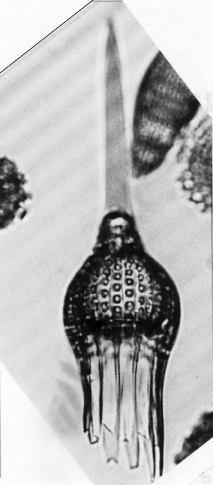 Calocycletta
(Calocyclissima) costata (Riedel)
Calocycletta
(Calocyclissima) costata (Riedel) Calocycletta
(Calocyclissima) costata (Riedel)
Calocycletta
(Calocyclissima) costata (Riedel)Calocyclas virginis Haeckel, Riedel, 1957, p.90, pl.4, fig.5 (partim.)
Calocyclas costata Riedel, 1959, p.296, pl.2, fig.9
Calocycletta costata (Riedel), Riedel and Sanfilippo, 1970, p.535, pl.14, fig.12
Cephalis ovate, lobed, with sparse subcircular to circular pores and bearing a stout, conical apical horn. Thorax subspherical, with pores circular, hexagonally arranged and with a pronounced tendency to longitudinal alignment, the longitudinal rows separated by pronounced costae. No lumbar stricture externally. Abdomen subcylindrical or tapering distally, narrower than the widest part of the thorax. Abdominal pores subcircular or circular, arranged hexagonally with apparent longitudinal alignment (these longitudinal lines are continuous with those of the thorax) and often with longitudinal ridges separating pore rows. Terminal feet eleven to eighteen in number, lamellar, usually truncate, parallel or slightly convergent, broader than the spaces between them, usually situated opposite alternate rows of abdominal pores. This species is distinguished from Calocyclas virginis by the pronouncedly costate thorax and otherwise smooth shell surface (Riedel, 1959).
Based on 30 specimens. Length of apical horn 115-230 µm; of cephalis 30-45 µm; of thorax 70-100 µm; of abdomen 10-33 µm; of feet 12-70 µm. Breadth of cephalis 38-53 µm; of thorax 103-135 µm; of abdomen (distally) 75-108 µm (Riedel, 1959).
Horn robust, conical. Thoracic pores in longitudinal rows, separated by ridges. Abdomen with a very short latticed part, and numerous parallel lamellar feet (Riedel and Sanfilippo, 1978a).
This species is distinguished from all others of the genus by the longitudinal ribs between the rows of thoracic pores, and the consequently very smooth contour. In addition to this, it differs from co-occurring specimens of C. virginis in that the latter usually have a distinct change in contour where the horn leaves the cephalis, and a more abrupt collar stricture. It differs from C. caepa Moore (1972; a member of the C. robusta group of Riedel and Sanfilippo, 1978a, p.66) in that the latter has a bladed horn, and a more delicate abdomen with smaller, more numerous pores, terminating in short, triangular teeth. There is a superficial resemblance also to Calocyclas turris Ehrenberg (1873), but that is an Eocene species with the simple cephalis characteristic of the theoperids (Sanfilippo et al., 1985).
The form of this species is remarkably constant over its entire geographic and stratigraphic range. The only variable character is the length of the lamellar feet, which depends principally on preservation - the feet are usually abruptly truncate as if broken, but in rare, well preserved specimens they taper to a point, and tend to diverge a little, after initial slight convergence (Sanfilippo et al., 1985).
This species occurs in samples of latest early to early middle Miocene age between 15°S and 30°N. It is absent at DSDP Site 173, at 40°N in the California Current region. It is present in sediments on Mallorca, at 39-40°N. Its morphotypic first appearance marks the base of the Calocycletta costata Zone and it becomes extinct within the Dorcadospyris alata Zone.
Calocycletta costata evolved directly from C. virginis by the development of longitudinal ribs on the thorax. In both species the thoracic pores are quincuncially arranged, but (at the time of their co-occurrence) in the former species the quincunxes are about 10% wider transversely than in the latter, because the bars between the pores are wider. Just before the origin of C. costata, specimens of C. virginis have somewhat larger pores (about 10 µm in diameter as compared to about 8 subsequently), and wider thorax (about 140-145 µm as compared to about 110-120 µm later) (Sanfilippo et al., 1985).
Additional illustrations can be found in Riedel and Sanfilippo, 1971, pl.2H, figs.12-14; Moore, 1972, pl.1, fig.8.
For generic level phylogeny see Sanfilippo and Riedel, 1992, p.30.